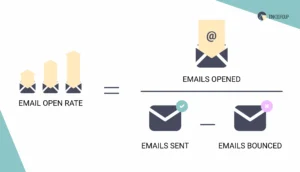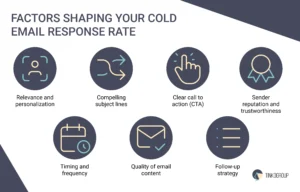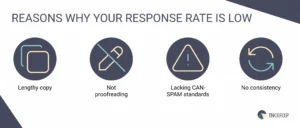In digital communication, cold emailing is both an art and a science—a delicate mix of creating compelling messages and guiding the inbox overload. As businesses and professionals strive to connect with potential clients, partners, or influencers, the unreachable metric of cold email response rates becomes an essential scope of success.
How do you break through the chill of anonymity to elicit a warm reply? Let’s dive into the nuanced strategies and insights that can melt even the iciest of inboxes, uncovering the secrets to boosting cold email response rates and generating meaningful connections in the digital age.
Let’s get started!
Definition of a cold email reply rate
In fact, cold emailing is a powerful tool for reaching out to potential clients, partners, or stakeholders. However, the effectiveness of cold emailing is often measured by its response rate – the percentage of recipients who engage with the email in some way.
First, a cold email is an unsolicited email sent to a recipient without prior relationship or interaction with the sender. Unlike warm or hot emails, sent to contacts who have expressed interest or engaged with the sender’s content, cold emails are typically sent as part of a targeted outreach campaign to initiate contact with new prospects.
On the other hand, the average cold email response rate refers to the percentage of recipients. They engage with a cold email by taking action, such as opening the email, clicking on a link, replying to the sender, or completing a desired conversion goal (e.g., scheduling a meeting or downloading a resource).
The typical response rate for cold emails is low, averaging around 8.5% out of 100 emails sent. Success in cold emailing hinges on strategic planning, timing, and experimentation. Adjusting the frequency of sending emails can significantly boost response rates; for instance, spacing out emails over four weeks rather than sending them all at once can increase responses by 20%.
Within cold email response rates, consistency is vital, akin to nurturing seeds over time. Furthermore, prompt responses from recipients tend to indicate a higher level of interest and should be monitored closely.
Cold email response rates vs. open rates
Cold emailing is a powerful tool for businesses aiming to reach potential clients or customers. However, measuring the effectiveness of cold email campaigns requires a clear understanding of metrics beyond just open rates. While open rates provide valuable insights into recipients’ initial engagement, response rates delve deeper into the level of interaction and conversion potential.
Open rates
They indicate the percentage of recipients who open a cold email out of the total number of emails delivered. This metric offers insights into the effectiveness of subject lines, sender reputation, and timing in capturing recipients’ attention.

Response rates
Average response rate for cold emails measures the percentage of recipients who not only open the email but also take action by replying, clicking on links, or engaging in any desired way. Unlike open rates, response rates provide a deeper understanding of recipient engagement and the effectiveness of the email content in prompting action.
While cold email response rates and open rates are distinct metrics, they are interconnected. A high open rate indicates that the subject line and sender information succeeded in grabbing recipients’ attention. However, an increased open rate does not guarantee a proportionate increase in response rates.
What’s the average cold email response rate?
The average cold email response rate can vary widely depending on various factors such as industry, target audience, email content, sender credibility, and timing.
Cold email response rates serve as a prime gauge of your email template’s efficacy. Reports indicate an average cold email response rate of 8.5%. This implies that out of every 100 cold emails dispatched, approximately 8 elicit a response.
Our collected data on cold email reply rates outlines the following:
- The top 25% of campaigns boast a reply rate of 20% or higher.
- Around 50% of cold email campaigns yield a reply rate below 10%.
- Approximately 25% of campaigns register a reply rate falling within the 10-20% range.
Main factors that influence your average cold email response rate
As mentioned, cold emailing remains a popular strategy for businesses aiming to expand their reach, generate leads, and drive conversions. However, achieving a high response rate in cold email campaigns can be challenging, requiring a strategic approach considering various factors influencing recipient behavior. Now, we’ll present the primary factors significantly impacting cold email response rates and discuss strategies to optimize each aspect for improved campaign performance.

- Relevance and personalization
One of the most influential factors in determining cold email response rates is the relevance and personalization of the email content. Recipients are more likely to respond positively to emails that address their specific needs, pain points, or interests.
Personalization goes beyond merely addressing recipients by name. It involves tailoring the content to resonate with their demographics, preferences, or past interactions with your brand. By using data and segmentation, businesses can create personalized messages that establish a connection with recipients and increase the possibility of a response.
- Compelling subject lines
These lines are important in catching recipients’ attention and enticing them to open the email. A captivating subject line should be concise, intriguing, and relevant to the recipient’s interests or concerns. Avoid generic or spammy subject lines likely to be ignored or marked as spam. Instead, focus on making subject lines that arouse curiosity, offer value, or convey a sense of urgency. A well-crafted subject line sets the stage for engagement and contributes to higher email response rates.
- Clear call to action (CTA)
A clear and compelling CTA is essential for driving recipient engagement and prompting a response. Whether requesting feedback, scheduling a call, or inviting recipients to explore a product or service, the CTA should be actionable and easy to understand. Position the call-to-action prominently within the email, making it effortless for recipients to take the desired action. A well-optimized CTA guides recipients toward the next steps and increases the chance of a cold email success rate.
- Sender reputation and trustworthiness
The credibility and trustworthiness of the sender significantly influence recipient perceptions and, consequently, response rates. Ensure that cold emails are sent from a recognizable sender name and email address associated with your brand. Building and maintaining a positive sender reputation involves adhering to email best practices, such as avoiding spammy tactics, maintaining a clean email list, and providing valuable content to recipients. Establishing trust with recipients increases the likelihood of them opening and responding to your emails.
- Timing and frequency
The timing and frequency of cold email outreach can significantly impact response rates. Sending emails at optimal times when recipients are likely to be engaged and receptive can increase the chances of a response. Experiment with different send times and analyze recipient behavior to identify the most effective timing for your target audience. Additionally, be aware of the frequency of your email communications to avoid overwhelming recipients. A well-planned rhythm ensures that your emails are seen as valuable rather than intrusive, contributing to higher email response rates.
- Quality of email content
The quality and relevance of the email content play a crucial role in determining recipient engagement and response rates. Ensure the content is concise, informative, and addresses the recipient’s needs or interests. Avoid overly promotional language and aim to provide value or solve a problem for the recipient. Personalize the content where possible, demonstrating an understanding of the recipient’s context and preferences. High-quality email content establishes credibility, fosters trust, and increases the likelihood of a positive response.
- Follow-up strategy
A well-structured follow-up strategy can significantly impact cold email response rates. In many cases, the initial email may not elicit a response, but a timely and relevant follow-up can reignite recipient interest and prompt a reply. Develop a sequence of follow-up emails that provide additional value, address potential objections, or offer incentives for responding. However, be mindful not to be too aggressive or redundant in your follow-up approach, as this can have the opposite effect and deter recipients from engaging with your emails.
How to calculate cold email response rates?
Cold email reply rate is a critical metric that quantifies the engagement and interaction generated by your cold email campaigns. It represents the percentage of recipients who take action or respond to your email in some way, whether by replying, clicking on links, expressing interest, or engaging in further communication. Calculating cold email response rates provides valuable insights into your cold email strategy’s effectiveness and helps you assess your outreach efforts’ impact.
To calculate the email marketing response rate for your email campaign, follow these steps:
Step 1. Define response metrics
Before calculating cold email response rates, it’s essential to define the specific actions that constitute a response in your campaign. These actions may include:
- Replies to the email;
- Click-throughs on links within the email;
- Requests for more information or a meeting;
- Any other desired actions indicative of engagement.
Step 2. Determine the total number of sent emails
Identify the total number of cold emails sent as part of your campaign. This figure serves as the denominator in the response rate calculation.
Step 3. Track responses
Track the responses received for your cold email campaign based on the defined response metrics. This involves tallying the number of replies, click-throughs, meeting requests, or other desired actions.
Step 4. Calculate response rate
Once you have the total number of responses and the total number of emails sent, use the following formula to calculate the average cold email response rate:

For example, if you sent out 500 cold emails and received 25 responses, the cold email response rate would be calculated as follows:

While cold email response rate is a fundamental metric for evaluating the success of your cold email campaign, it’s essential to consider additional metrics to gain a more comprehensive understanding of performance. Some key metrics to consider include:
- Open rate: The percentage of recipients who open your cold email. An average cold email open rate provides insights into the effectiveness of your subject lines and the overall deliverability of your emails.
- Click-through rate (CTR): The percentage of recipients clicking links or CTAs within your email. CTR indicates the level of recipient engagement with your email content.
- Conversion rate: The percentage of recipients who complete a desired action, such as making a purchase or scheduling a meeting, as a result of your cold email campaign. Conversion rate measures the effectiveness of your campaign in driving desired outcomes.
- Reply rate: Specifically, the percentage of recipients who reply to your cold email. An average reply rate cold email is a direct measure of engagement and indicates the effectiveness of your email content and messaging.
When to send cold emails: top cases
In email marketing, timing plays a vital role in determining the success of your campaigns. When it comes to cold emailing, choosing the right time to send your messages can significantly impact open rates, response rates, and overall campaign effectiveness. So, let’s discover the optimal timing for sending cold emails, highlighting key considerations to help you make informed decisions for your outreach strategy.
The most effective time to send emails is 1 p.m.
Based on various studies and analyses of email engagement patterns, the notion that 1 p.m. is the most effective time to send emails has gained popularity. The rationale behind this timing is that recipients are likely to check their emails during their lunch break, making 1 p.m. an opportune moment to capture their attention.
While 1 p.m. may be a favorable time for some recipients, it’s essential to recognize that email engagement patterns can vary significantly based on industry, geographic location, and individual preferences. What works for one audience may not necessarily apply universally.
Rather than relying solely on generalized recommendations, consider segmenting your email list based on factors such as time zone, industry vertical, and recipient behavior. Conduct A/B testing to experiment with different send times and analyze the results to identify the optimal timing for engaging with each segment of your audience.
Monday and Tuesday are the best days to send cold emails
The belief that Monday and Tuesday are the best days to send cold emails arises from the idea that recipients are more likely to be responsive and engaged at the beginning of the workweek. However, this assertion overlooks that Mondays can be hectic for many professionals as they catch up on emails and prioritize tasks for the week ahead.
Similarly, Tuesdays may see a higher volume of emails flooding recipients’ inboxes, potentially leading to greater competition for attention. While there may be some merit to targeting early weekdays, it’s essential to consider the unique dynamics of your target audience and industry.
Instead of exclusively focusing on Mondays and Tuesdays, consider exploring engagement opportunities throughout the week. Wednesdays and Thursdays balance the initial rush of the workweek and the fatigue that can set in towards the end of the week. Experiment with different days and monitor engagement metrics to identify patterns and trends specific to your audience.
Weekend emails receive minimal engagement
There’s a common belief that sending emails over the weekend is useless, as recipients are less likely to engage with their inbox outside regular business hours. While it’s true that weekends may see lower overall email activity compared to weekdays, dismissing weekend emails entirely overlooks potential opportunities to stand out and capture recipients’ attention when their inboxes are less crowded.
Rather than writing off weekends altogether, consider targeting specific windows of opportunity when recipients may be more receptive to email communication. For example, early Saturday mornings or Sunday evenings may present opportunities to reach professionals who use weekends to catch up on work or plan for the week ahead. You can test different timing strategies and analyze engagement metrics to determine the effectiveness of weekend outreach for your audience.
Thus, by continuously refining your approach and staying responsive to recipient behavior, you can maximize the impact of your cold email outreach and achieve better results. Remember, effective timing isn’t just about sending emails at specific times—it’s about sending the right message to the right audience at the right time.
Main factors that decrease your reply rate
In fact, achieving a high cold email response rate is essential for driving engagement, nurturing relationships, and, ultimately, reaching business objectives. However, several factors can contribute to a reduction in email reply rates, undermining the effectiveness of your campaigns and hindering your ability to connect with your audience. Let’s check these challenges together!

engthy copy
One of the most common pitfalls that can decrease your cold email response rate is using lengthy copy. Today, attention spans are shorter than ever, and recipients are often inundated with constant emails vying for their attention. Lengthy emails that drone on without getting to the point risk losing the reader’s interest and may be quickly dismissed or deleted without a response.
To combat the issue of lengthy copy:
- Prioritize brevity and conciseness in your email communications.
- Keep your messages clear, focused, and concise, avoiding unnecessary fluff or verbosity.
- Use short paragraphs, bullet points, and subheadings to break up the text and make it easier for recipients to digest.
Not proofreading
Another factor that can significantly decrease your cold email response rate is sending emails containing spelling errors, grammatical mistakes, or formatting issues. Sloppy, unprofessional emails can reflect poorly on your brand image and credibility, undermining recipient trust and reducing the likelihood of a response.
Thus, prioritize thoroughly proofreading and editing your email content before sending it out to your audience. Use spelling and grammar checkers, review your content multiple times, and consider enlisting the help of a colleague or professional proofreader to ensure accuracy and clarity. Pay attention to formatting, layout, and design elements to create visually appealing and polished emails that inspire confidence in your brand. Presenting yourself as professional and reliable increases the chances of recipients engaging with your message.
Lacking CAN-SPAM standards
Failing to adhere to CAN-SPAM (Controlling the Assault of Non-Solicited Pornography And Marketing) Act standards can also contribute to a decrease in your cold email response rate. CAN-SPAM is a law that sets forth requirements for commercial email messages, including sender identification, opt-out mechanisms, and content labeling provisions. Email service providers or recipients may flag emails that violate CAN-SPAM regulations as spam, resulting in lower deliverability and email response rates.
It is a great idea to ensure compliance with CAN-SPAM standards by including accurate sender identification, providing a clear and conspicuous opt-out mechanism, and labeling your emails as advertisements when necessary. Respect recipients’ preferences and honor opt-out requests promptly to maintain trust and credibility with your audience. Familiarize yourself with CAN-SPAM requirements and implement processes and procedures to ensure ongoing compliance in your email marketing practices.
No consistency
In fact, consistency—or lack thereof—in your email marketing efforts can also contribute to a decrease in email response rates. Inconsistent frequency, messaging, or branding across your email communications can confuse recipients and dilute the impact of your messages. Additionally, sporadic or irregular email cadence may make it difficult for recipients to anticipate and engage with your emails consistently.
So, you can establish a consistent and predictable cadence for your email communications, considering factors such as frequency, timing, and messaging. Develop a content calendar or editorial schedule to plan and organize your email campaigns in advance, ensuring they align with your overall marketing strategy and objectives. Maintain consistency in your branding, tone of voice, and visual identity across all emails to reinforce brand recognition and trust with your audience. By delivering a cohesive and predictable experience, you create a foundation for more robust engagement and email response rates.
Valuable tips to enhance your cold email response rates
Achieving high response rates is crucial for the success of your cold email campaigns. Capturing recipients’ attention and prompting them to engage with your message requires a strategic approach that combines compelling content, personalized communication, and thoughtful follow-up. Below are actionable tips to improve cold email response rates and drive meaningful interactions with your target audience.
Provide value in the email content
Once recipients open your cold email, it’s essential to deliver value and relevance to keep them engaged. Clearly communicate the benefits of your product or service and how it addresses the recipient’s needs or challenges. Focus on providing actionable insights, valuable resources, or personalized recommendations, demonstrating your expertise and establishing credibility. Keep the content concise, engaging, and easy to digest, and avoid overwhelming recipients with unnecessary information.
Segment your email list
Segmenting your email list allows you to tailor your cold email campaigns to different audience segments based on demographics, industry, or engagement level. By targeting specific segments with relevant content and messaging, you can increase the possibility of resonating with recipients and driving higher email response rates. Use data and analytics to identify meaningful segmentation criteria and refine your segmentation strategy based on recipient behavior and campaign performance.
Test and iterate
Continuous testing and iteration are essential for optimizing cold email campaigns and improving email response rates. Through A/B testing, you can experiment with variables such as subject lines, email content, CTAs, and send times to identify what resonates best with your audience. Analyze the results of your tests and use the insights gained to refine your approach and make data-driven decisions. By testing and iterating on your cold email campaigns, you can uncover hidden opportunities for improvement and maximize the effectiveness of your outreach efforts.
In general, by implementing these tips and best practices, you can elevate the effectiveness of your cold email campaigns and drive meaningful interactions with your target audience. Remember to stay responsive to recipient feedback and adapt your approach based on real-time data and insights to achieve sustained success in your email marketing efforts.
Final thoughts
In conclusion, learning cold email response rates requires strategic finesse and genuine human connection. By understanding the difficulties of recipient psychology, optimizing your messaging for relevance and personalization, and continuously refining your approach based on data-driven insights, you can elevate your outreach efforts from mere transactions to authentic conversations. Remember, behind every email address lies a potential relationship waiting to be cultivated.
Ready to take your cold email game to the next level? Let our lead generation experts help you analyze, optimize, and streamline your outreach campaigns for maximum impact. Contact us today to schedule a consultation and discover how our tailored email list building services can boost your cold email response rates and drive meaningful connections.
FAQ
What is good email response rate?
A reasonable email response rate typically hovers around 20-30%. However, the ideal rate can vary depending on factors like industry, target audience, and the specific nature of your emails. It’s essential to monitor your response rates and strive for improvement through targeted strategies.
What is the average email response time?
The average email response time varies across industries and organizations. Studies suggest that responding to emails within 24 hours is considered standard practice for most businesses. Timely responses demonstrate professionalism and foster positive relationships with clients and colleagues.

